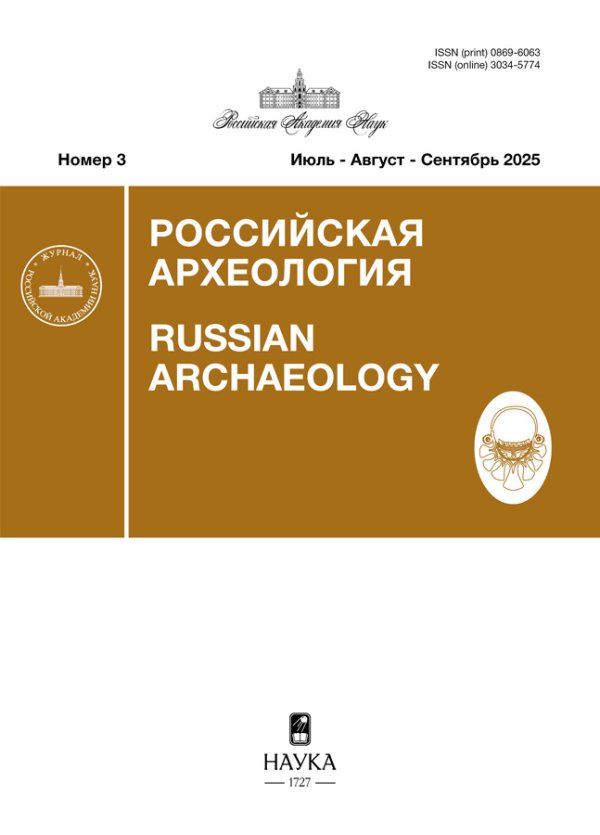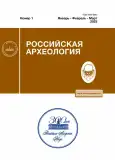THE HEIGHT OF CHILDREN IN RUSSIAN TOWNS IN THE 15th–17th CENTURIES
- Authors: Chechetkina O.Y.1
-
Affiliations:
- Institute of Archaeology RAS
- Issue: No 1 (2023)
- Pages: 128-134
- Section: ARTICLES
- URL: https://journals.rcsi.science/0869-6063/article/view/138837
- DOI: https://doi.org/10.31857/S0869606323010075
- EDN: https://elibrary.ru/MBSVVK
- ID: 138837
Cite item
Full Text
Abstract
Fieldwork of the Institute of Archaeology RAS in recent years has made it possible to unearth several hundred children’s burials, which belong to a narrow chronological range. Comparative research into these materials enabled to refine our understanding of the life quality of Russian towns’ population during the late Middle Ages. The study sample includes the remains of children aged from new-born to 10 year-old from the 16th–17th centuries cemetery at the Church of St. John Chrysostom, Yaroslavl, and a synchronous sample from the excavations of the Tula Kremlin. For comparison, previously published materials from excavations of other contemporary necropolises were employed. In constructing growth graphs, only those cases were taken into account, where the preservation made it possible to determine the age by the teeth confirmed by microfocus radiography. The lengths of tubular bones in children from all archaeological samples were smaller (with the exception of the sample from the Novokharkovskoye cemetery) than modern standards. Children from Yaroslavl, Tula and Mozhaysk were smaller than children of the 14th–17th centuries from the Lithuanian city of Alytus. Between the ages of one to seven, they were considerably smaller than the English children from Yorkshire (Wharram Percy Cemetery), but then overtook them in size. Comparison with Polish urban samples shows an early growth acceleration in Yaroslavl and Tula children at the age of seven rather than at eight. However, the clavicle length in children under the age of 10 from archaeological samples was practically the same as in the modern group, which probably imply that this feature can be used to determine the biological age of young children in groups of similar chronology.
About the authors
Olga Yu. Chechetkina
Institute of Archaeology RAS
Author for correspondence.
Email: chechyotkina91@bk.ru
Russia, Moscow
References
- Black S.V., Scheuer J.L., 1996. Age changes in the clavicle: from the early neonatal period to skeletal maturity. International Journal of Osteoarchaeology, vol. 6, iss. 5, pp. 425–434.
- Jankauskas R., 1992. Osteometry of the 14th–17th cc. children’s skeletons in Lithuanian paleoosteological materials. Papers on Anthropology, V, pp. 36–46.
- Kabatov S.A., Kabatova E.A., Mednikova M.B., 2022. Isotope and anthropological studies of the burials of the Old City in the second Kostroma Kremlin. Arkheologiya Podmoskov’ya: materialy nauchnogo seminara [The archaeology of Moscow region: Proceedings of scientific seminar], 18. A.V. Engovatova, ed. Moscow: Institut arkheologii Rossiyskoy akademii nauk, pp. 192–218. (In Russ.)
- Krenz-Niedbala M., 2017. Growth and health status of children and adolescents in medieval Central Europe. Anthropological Review, 80 (1), pp. 1–36.
- Liversidge H., Dean M., Molleson T., 1993. Increasing human tooth length between birth and 5.4 years. American Journal of Physical Anthropology, 90, 3, pp. 307–313.
- Malina R.M., 1990. Research on secular trends in auxology. Anthropologischer Anzeiger, vol. 48, no. 3, pp. 209–227.
- Maresh M.M., 1970. Measurements from roentgenograms. Human growth and development. Springfield, IL: C.C. Thomas, pp. 157–200.
- Mays S., 1999. Linear and appositional long bone growth in earlier human populations: a case study of Mediaeval England. Human Growth in the Past: Studies from Bones and Teeth. R. Hoppa, C. FitzGerald, eds. Cambridge: Cambridge University Press, pp. 290–312.
- Mednikova M.B., 2002. Features of the skeletal constitution of the buried. Novokhar’kovskiy mogil’nik epokhi Zolotoy Ordy [The Novokharkovskoye burial ground of the Golden Horde period]. Voronezh: Mezhregional’nyy institut obshchestvennykh nauk, pp. 129–145. (In Russ.)
- Mednikova M.B., Tarasova A.A., 2022. Population of Russian towns of the Modern period based on anthropological source: Peculiarities of growth processes and a secular trend. V poiskakh boyar Romanovykh: mezhdistsiplinarnoe issledovanie usypal’nitsy XVI–XVIII vv. v Znamenskoy tserkvi Novospasskogo monastyrya v Moskve [In search of the Romanov Boyars: An interdisciplinary study of the tomb of the 16th–18th centuries AD in the Church of the Sign of the Novospassky Monastery in Moscow], 2. N.A. Makarov, ed. Moscow: Club Print, pp. 67–87. (In Russ.)
- Moorrees C.F.A., Fanning E.A., Hunt E.E., 1963б. Formation and resorption of three deciduous teeth in children. American Journal of Physical Anthropology, 21, 2, pp. 205–213.
- Moorrees C.F.A., Fanning E.A., Hunt E.E., 1963а. Age variation of formation stages for ten permanent teeth. Journal of Dental Research, 42, 6, pp. 1490–1502.
- Schaefer M., Black S., Scheuer L., 2009. Juvenile osteology. A laboratory and field manual. Amsterdam: Elsevier. 369 p.
- Tarasova A.A., Chechetkina O.Yu., 2021. Anthropological materials from excavations on the territory of the Mozhaysk Kremlin. Preliminary report. Vestnik Moskovskogo universiteta. Seriya XXIII: Antropologiya [Moscow University Anthropology Bulletin], 1, pp. 125–138. (In Russ.)
- Ubelaker D.H., 1978 (1979). Human skeletal remains: excavation, analysis, interpretation. Chicago: Aldine Publishing. 116 p.












